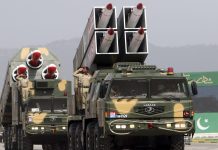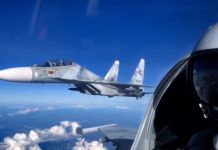Ahead of the British HMS Prince of Wales’ Indo-Pacific deployment, British media boasted that the F-35 air wing can outperform the air capabilities of China’s Liaoning and Shandong aircraft carriers. However, with the F-35B making emergency landings one after another, the facade seems to have fallen off.
The deployment of the HMS Prince of Wales after a four-year hiatus was seen as a signal to China. Experts speculated in April 2025 that the British carrier could face off against its Chinese counterparts, the Liaoning and the Shandong.
A report published in the British publication, The Telegraph, pitted the British carrier against China. It stated with conviction that the British aircraft carriers have a huge advantage over the current aircraft carriers of the Chinese People’s Liberation Army Navy (PLAN).
It asserted that the British Prince of Wales aircraft carrier can deal with both the Liaoning and Shandong aircraft carriers of China simultaneously.
The report went on to say that in a hypothetical open-ocean combat scenario, the HMS Prince of Wales’ F-35 air wing will outperform the air capabilities of the Liaoning and Shandong aircraft carriers.
It contended that the Royal Navy’s fifth-generation F-35s would offer a significant advantage in a deep-blue naval conflict against the land-based Chinese J-15s stationed aboard their carriers, in the case of a conflict.
The report added: In a few years, when the new Fujian aircraft carrier is ready, things will be very different. This year, however, would not be a good year for the Chinese to come out. This is especially true, as the British Carrier Group will be accompanied by an Astute-class attack submarine. Chinese anti-submarine warfare (ASW) is not yet good enough to cope with probably one of the best and most dangerous attack subs in the world, and if the gloves came off, a lot of Chinese ships would wind up on the seabed.
However, things have taken a sharp turn since this report was published.
While China is all set to induct the Fujian aircraft carrier later this year, its fifth-generation J-35 is already operational, and the improved J-15T is being tested aboard the newest EMALS (Electromagnetic Aircraft Launch System) equipped Fujian carrier.
The J-35 is a fifth-generation carrier-capable stealth jet that resembles and is comparable to the F-35B operated by the UK and the US.
Meanwhile, the prowess of the British F-35B stealth fighter has increasingly come under scrutiny. In June 2025, the aircraft had to make an emergency landing while flying over the Indian Ocean. It was diverted to Thiruvananthapuram, Kerala, in India, owing to poor weather and limited fuel.
Later, it was revealed that the aircraft had a hydraulic system issue that damaged its landing gear, brakes, and control surfaces.

The aircraft remained stranded at the location for about five weeks, piquing the interest of aviation enthusiasts, who observed that the incident would result in ‘bad marketing’ for Lockheed jets.
The F-35B’s stay in India also triggered a massive meme-fest, with netizens, analysts, and even the Kerala tourism department mocking the prolonged stay of the aircraft in the state.
The F-35B finally left India for Darwin, Australia, on July 22 after a specialist UK engineering team completed the necessary repairs and safety checks.
Another Emergency For British F-35B?
After encountering an unknown technical fault, a British F-35B Lightning stealth fighter jet was forced to make an emergency landing in Japan on August 10. The aircraft, operating out of the deck of the HMS Prince of Wales aircraft carrier, reportedly landed at the Kagoshima international airport at around 11.30 am local time.
According to reports in local Japanese media, the runway operations were halted for about 20 minutes as the F-35B in question was transferred to a taxiway for inspections. The Japanese Defense Ministry stated the aircraft had an engineering problem and was undergoing checks to allow it to return to the carrier group as soon as possible. However, it did not mention when the aircraft would be fixed and declared airworthy again.

The air wing of the British carrier consists of 24 F-35B Lightning II jets from the Royal Navy and Royal Air Force, alongside helicopters.
The aircraft that made an emergency landing in Japan was participating in joint exercises with American and Japanese forces as part of ‘Operation Highmast’, aimed at showing off Britain’s security responsibilities in the Indo-Pacific.
The incident came just a day after a British F-35B landed on the Japanese JS Kaga carrier for the first time as part of this operation.
“There’s a first for everything… The 1st F-35B jet lands on a Japanese ship,” the UK Carrier Strike Group, led by HMS Prince of Wales, wrote on X, confirming the event.
Chinese state-run media were quick to exploit the opportunity, which could be perceived as a comeback to the tall claims made by the British media earlier.

Responding to the situation, a Chinese expert cited by state-run publication Global Times said that the two incidents highlighted the F-35B’s excessively complicated equipment and extremely demanding maintainability, which the UK sailors may find difficult to handle during deployments to far-off seas.
The chief editor of Beijing-based Aerospace Knowledge magazine, Wang Ya’nan, said that the F-35B is the most technically demanding version of the F-35 family because of its vertical landing capability and short takeoff, which presents major maintenance issues.
He said that long-term carrier operations so far from home may make it difficult for the UK military to offer sufficient maintenance assistance for the US-made jets.
Wang further said that in some ways, the UK’s aircraft carrier deployments mirror the US’s global strategy, which includes its reliance on US-made equipment. He emphasized that the British Navy’s operational capabilities have changed from a technical standpoint, and the recent malfunction incidents should prompt a reevaluation of its policy of accommodating US interests in the Indo-Pacific.
However, the emergency landing episodes and prolonged grounding in India have raised questions about the F-35 program’s reliability, especially given its high costs and past technical issues. Earlier, an F-35B belonging to the UK crashed in 2021.
Meanwhile, Chinese military bloggers quickly jumped the gun. They believed that two continuous incidents involving the British F-35B could trigger a rethink in Japan.
“The Japanese Self-Defense Forces originally had high hopes for the F-35B. It believed that after this fighter was integrated with the Izumo and Kaga frigates, the Japanese Maritime Self-Defense Force would have two so-called light aircraft carrier combat systems. When carrying out ocean-going combat missions, it could use the F-35B to seize air control, or at sea, land, and island targets. Now, in the process of the U.S.-led multilateral exercises, Japan may have identified the F-35B as unreliable. Still, there is no other choice but to introduce the F-35B from the United States,” it added.
- Contact the author at sakshi.tiwari9555 (at) gmail.com
- Follow EurAsian Times on Google News




